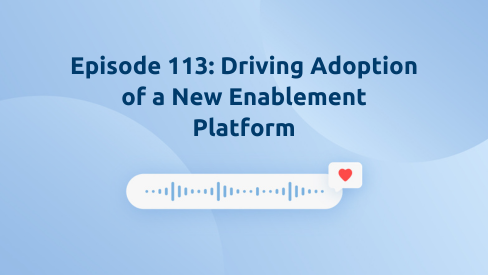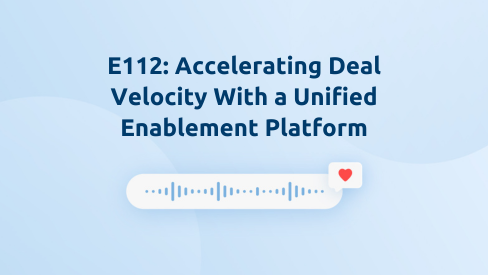In a survey conducted by Highspot, we found that 94% of customers report the user experience as a key factor that drove their decision to choose Highspot. So, how can you maximize ease of use with Highspot to deliver a great experience for your teams?
Shawnna Sumaoang: Hi and welcome to the Win Win Podcast. I’m your host, Shawnna Sumaoang. Join us as we dive into changing trends in the workplace and how to navigate them successfully. Here to discuss this topic is Lynton Steyn, senior manager of sales systems of engagement at NTT Ltd. Thanks for joining, Lynton! I’d love for you to tell us about yourself, your background, and your role.
Lynton Steyn: Thank you very much. A little bit about myself, I come from a hospitality background and worked in the hotel industry for a couple of years, which helped me develop a service-oriented mindset. I’ve been with NTT now for 11 years, first starting as a SharePoint developer within the application development space, and then eventually moving into marketing and supporting our global intranet, working within SharePoint, and then also supporting solutions within marketing and demand generation. I eventually ended up in sales, where I’m currently situated within our sales digital transformation team as a senior manager, working with our sales enablement teams.
SS: Wonderful. I’m so glad to have you here. Now, at NTT, as you mentioned, you oversee the technical implementation of Highspot. Can you share a little bit about the implementation process and how did you roll Highspot out with ease to your teams?
LS: Well, I have to first say that the success of that rollout was largely due to the engagement with Highspot as a partner. The evaluation of that suitable partner was quite a rigorous process because while we were going through the evaluation stage, we had to go through various gates as an organization within our architectural review committee. This was largely to ensure that our DPIA or data protection impact assessments were completed successfully. There were quite stringent legal requirements that we needed to fulfill from GDPR, et cetera.
Partnering with Highspot for that rollout, which we initially did as a pilot with a small audience of our larger user base was very successfully received by the business. Once we had outlined what the future requirements of the platform would be working as a consultative approach with Highspot, we moved into the final release of the production environment, which has been really well received.
SS: Well, I always love to hear that. Thank you so much, Lynton, for a fantastic partnership. Since the initial implementation, how have you seamlessly scaled the use of Highspot at NTT?
LS: Working with Highspot in a business our size, we work pretty closely with our executive leadership team and then several of our internal stakeholder groups, for example, marketing. We’ve got a number of service portfolios within the organization, so we had to stay closely tied to our service division leads as we built out and crafted what that solution would look like.
What we eventually landed on were some key aspects of Highspot as a sales enablement platform. The first is really about putting the control of curation and the management of content into the hands of the people responsible for managing content and the capability of Highspot with the spot features is really simple to address that requirement. We found it very effective in being able to actually build out those areas for our content managers.
We also needed to really consider some important aspects of how we onboard our regional services. Within NTT, we have a global portfolio of services, but we also have important regional service offers that need to be incorporated within that. Thanks to the incredible work that we were able to achieve with some of the vendor specialists, we were able to basically define a mechanism using the global lists and the tagging within Highspot to be able to build out the use cases for those regional services and then address that requirement.
Now, once we’d actually done that, we started to realize that there was also a need for us to be able to separate our production environments and provide pre-release staging environments. Working with the likes of Highspot, it was really amazing the challenge that was put in front of us and how we were able to work with Highspot in setting up staging environments where we could have our pre-release content go through the approval processes that Highspot supports and then have those assets moved into the production environments in a managed way. That was really wonderful. Thank you.
SS: Absolutely. I love that. Now, you focus on the ongoing management of Highspot and one of your areas of focus is partnering with what you guys have established as your governance committee. What does that partnership look like and how can it help you really kind of maintain the ease of use of Highspot?
LS: That’s a very interesting question. Within NTT, portfolio governance plays a crucial role within our organization. At the fundamental level, it ensures that we streamline the release of a common information model across all our Tier 1 platforms, which range from SAP to Salesforce, Direct, and our chart of accounts. Supporting the life cycle of the service codes on Highspot is where I come into play and my responsibility is to maintain a regular cadence with our Global Portfolio Governance Committee thereby I complete impact assessments related to those portfolio changes, how they impact Highspot and how they would impact the structure of that taxonomy that we support within the platform.
SS: I love that you guys have a governance committee established at NTT because it’s definitely showing in the results. I mean, your team has driven fantastic content governance. I believe you guys have 74 percent of your content well governed, which is amazing, Lynton. Especially given the size and scale of NTT, what are your best practices for maintaining that effective content governance?
LS: We really needed to take a proactive approach to how content is utilized within the platform. Now, if you look at the power of the platform it is really an AI, search, and filtering mechanism. That makes it really easy for people and sellers to find the content readily. We needed to be able to build out those areas for content usage to ensure that content was found relatively quickly and that the content was being managed in such a way that it was consistent, accurate, and easy to retrieve.
We found that working with the Highspot platform, some of the things that support that, for example, your spot policies go a long way to make sure that the content within the platform is accurate, is properly indexed so that the search can retrieve it accurately.
From an administrative point of view, we leverage the Spot List Report. I use it almost daily because the Spot List Reports for me, basically allows me to analyze our content curation areas to see where there are spot violations occurring. You can almost proactively manage those violations on the go. It can happen almost instantly because the retrieval of those violations is done so dynamically in real time. Those reports are really useful.
Also, we incorporated all those analytics reports that we get given by the platform into functional operational reports that we share with our service divisions because we’re able to then surface those spot violations up front and we can get them resolved fairly quickly. That has really been useful.
Not that it’s the last that I’m mentioning, because it’s certainly equally important, but the content scorecard is just absolutely fantastic. A Wealth of information is in those scorecards. It ranges from the insights into the behavior and the governance that we’re trying to nurture with our sellers and our curators of the content, trying to also surface where content is relatively stable. If the content hasn’t been viewed over a certain period of time, the governance tab within your scorecards can surface that information very readily.
The other beauty about it is that all those reports are surfaced within your content list report. You can almost slice and dice that content list reports to your needs. As an organization, you’re able to build out more sophisticated reports for yourself and it gives you the ability to save those reports, which is just as effective. A lot of the time you’ve got something that’s really beneficial to you as a business owner and each time you would have to go and configure this report to do it for you, but within Highspot, you can just save the report and refer back to it at any time, which is fantastic.
SS: Because you guys do such a fantastic job at that proactive content governance, you also have a really impressive content findability rate at 90%. What are some of your strategies for ensuring that content is easy to find in Highspot?
LS: I think that talks back to when we originally took on Highspot as a partner. The importance of defining metadata and a naming convention standard upfront and early is really important. At the end of the day, it influences how content is retrieved and searched for within the platform. We placed quite a bit of focus on making sure that content is correctly named, that there are descriptions, and that there are feedback owners and authors associated with all the content. That goes a long way just in itself to make sure that the search is supported as the best means to retrieve content.
The content list report, as I said, is pretty good for monitoring any potential issues with content, but it also is a very important tool for the administrators of the platform and the sales enablement teams to see where there’s a duplication of content. Now, some of the power of Highspot is with bookmarking of content, which I think is just absolutely wonderful, because there’s a single source of truth and no matter how many times you bookmark that content it’s going to remain consistently refreshed at the source.
The duplication mechanisms within the analytics reports give you an added benefit because you can narrow down where there is duplication occurring and correct it very quickly. I personally like to use the search performance reports within the Highspot. Now the search performance reports for me is where I can almost nurture the platform to my particular needs as an administrator. I pay close attention to the search reports because within that I can then start to analyze what my users are searching for.
Based on those key phrases, I can start building out those search synonyms, and I can start using the promoted search features within Highspot to make sure that the content that I wish my sellers to get to is being surfaced up front. This is a very powerful tool. All this is configurable within the company settings tab. In other platforms, it’s extremely intensive for the user to try and do this. You’ve got to configure really powerful queries within SharePoint, for example, to be able to do that sort of thing. Whereas within Highspot, it’s almost a given and very easy to configure. I think it’s remarkable from a development point of view.
SS: Wonderful. Now shifting gears a little bit, Lynton. Earlier this year, your team made some pretty major updates to the service catalog, which affected how content was organized in Highspot. How did Highspot help you easily navigate this pretty complex transformation?
LS: Highspot certainly as an organization was pivotal in supporting that change. When we initially built out what we imagined our Highspot instance would look like, we fell into the trap of essentially re-engineering our intranet into Highspot. We were very quickly course-corrected early on with the help of Highspot in what good looks like. Some really key lessons for us we were able to take away. Because of the way and the nature of Highspots configuration and the ability to change things readily, we were able to build out individual spots for each of our service portfolios.
Then using our Global Portfolio Governance Committee as a guide, our Northern Star so to speak, we were then able to orchestrate the changes to our global lists, ensure that there were supporting tags around our bill of materials for sales enablement as a content type, region, country, et cetera. All those added benefits for our filtering of content for our seller, we were able to then incorporate in those spots for the SMEs working within those service divisions.
SS: That is fantastic. I know another way that you’re working to really equip your teams for success by providing them with guidance. I know your team, for example, recently implemented a sort of breadcrumbing in sales plays to guide users from central information to more granular details. Can you tell us a little bit more about this effort?
LS: Certainly. We maintain a very close relationship with our sellers to constantly garner where the areas of improvement needed from the process and from an implementation perspective. Some of the early feedback that we received was that the sellers were still struggling to find content quickly, and it was largely due to the way that we are trying to basically build out a traditional website approach and not enhance ourselves with the power of the Highspots filtering mechanism.
Once we had course corrected that into using the full power of Highspots filtering and the tagging within the Highspot, we then did is we worked on each of our overviews within Highspot and provided that breadcrumb and a high-level sitemap, which is equally important. They’re very simple tools within a front-end developer’s toolbox, but they really do provide the seller a breadcrumb for them to be able to, wherever they are within the content, easily find their way back to where they originally come from, and that was really wonderful.
SS: I love that. Tell us a little bit more. How does delivering guidance for your teams, such as through sales plays, help you streamline your team’s workflows so that they can actually enhance their productivity?
LS: Part of my work within NTT and within the sales digital transformation team is to pay close attention to the user experience of our service offers, and how the sellers engage with that content. I focus largely on building out the overviews and the sales players in the visual presentation layer with our sales enablement team working with the service divisions to make sure that the seller-centric content to drive behavior is built out inside of those templates.
Now, I applied some, I wouldn’t say they’re pretty simple, but UX Gestalt principles of uniformity and conformity to the templates within Highspot. Because of this, it essentially creates a quick mind map for someone who’s on the page. They know what to expect and in which relative areas of the overview to look for content that’s related to that. Then, using the Salesforce recommendation spot, which is basically the targeting of content within other platforms like Salesforce, is a really powerful tool in order to surface that content to the seller, no matter which platform they are on. That’s gone a long way to improve our adoption rates.
SS: You guys are also working to streamline sales workflows by leveraging several integrations with Highspot. In fact, I think your team recently implemented Highspots integration with Microsoft Teams. How has that boosted productivity and helped you continue to maintain that ease of use?
LS: Most definitely it has by surfacing both buy and deal intelligence in applications where our sellers spend most of their time, such as Teams and Outlook, we drive better outcomes and we have better insights into how people are working within the platform. The one thing about Highspots Teams integration that I find really very useful for our sellers is if you look at the team’s integration in close proximity to the digital sales rooms and the ability for that B2B collaboration and bi-directional communication between sellers and their prospective clients, then to tie it all in together into, the engagement metrics that you can get from Highspot in terms of how that goes, I think the future is really bright and it’s really a wonderful way for us to be able to engage our buyers.
SS: I love that. Last question for you, Lynton. As we enter 2024, what are some of the key initiatives your team is focused on and how will you leverage Highspot to help support these?
LS: I think that, from where we are currently as an organization and the maturity that we have within Highspot, we would be looking to focus more on important integration, such as the upcoming Microsoft 365 Copilot for sales. I think that’s really on my chart of things to look at.
I do see following the Spark conference, the drive that Highspot has towards artificial intelligence, which I think has got tremendous opportunity within Highspot, both to support our sellers and to help our sellers curate the right messaging for the buyer. Something that we got a bit of a bird’s eye view recently in looking at the meeting intelligence, which is basically for us, a wonderful mechanism to improve our coaching with our sellers. I’m looking forward to that a lot.
SS: I love hearing that. Thank you so much for tuning in to Spark ‘23. Lynton, thank you so much for joining us today. I really appreciate it.
LS: Absolute pleasure. Thank you for inviting me.
SS: To our audience, thank you for listening to this episode of the Win Win Podcast. Be sure to tune in next time for more insights on how you can maximize enablement success with Highspot.



